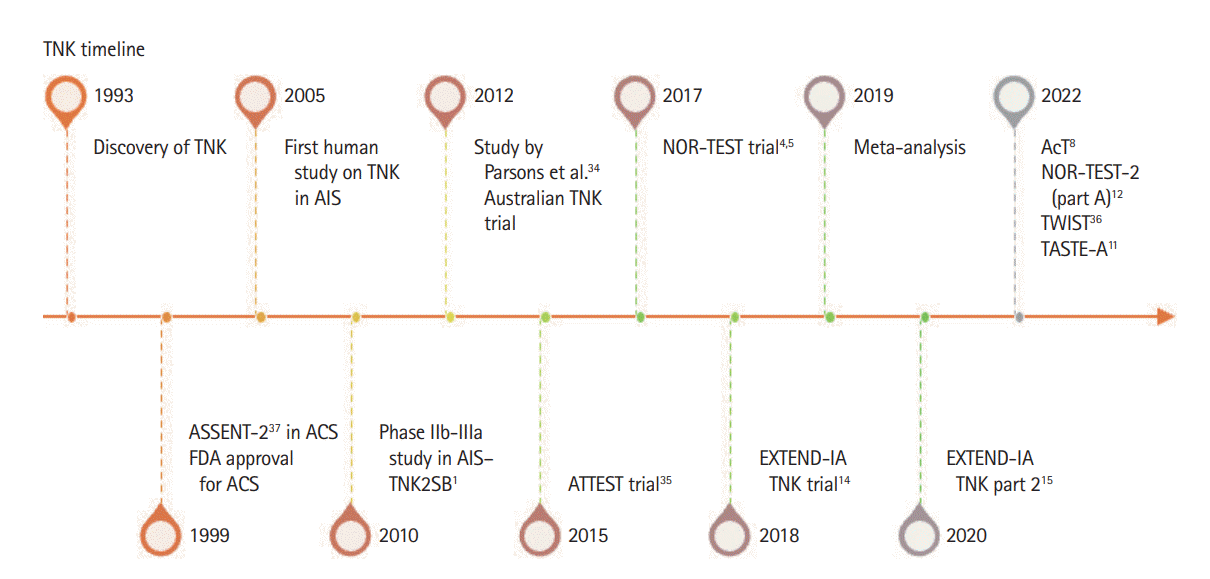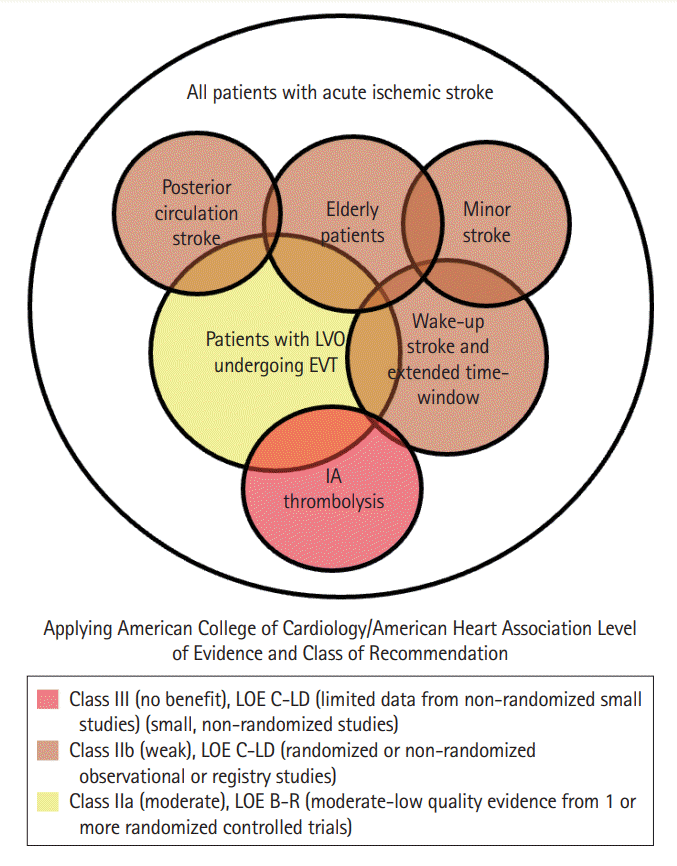1. Haley EC Jr, Thompson JL, Grotta JC, Lyden PD, Hemmen TG, Brown DL, et al. Phase IIB/III trial of tenecteplase in acute ischemic stroke: results of a prematurely terminated randomized clinical trial. Stroke. 2010; 41:707–711.
2. Coutts SB, Dubuc V, Mandzia J, Kenney C, Demchuk AM, Smith EE, et al. Tenecteplase-tissue-type plasminogen activator evaluation for minor ischemic stroke with proven occlusion. Stroke. 2015; 46:769–774.
3. Kheiri B, Osman M, Abdalla A, Haykal T, Ahmed S, Hassan M, et al. Tenecteplase versus alteplase for management of acute ischemic stroke: a pairwise and network meta-analysis of randomized clinical trials. J Thromb Thrombolysis. 2018; 46:440–450.
4. Katsanos AH, Safouris A, Sarraj A, Magoufis G, Leker RR, Khatri P, et al. Intravenous thrombolysis with tenecteplase in patients with large vessel occlusions: systematic review and meta-analysis. Stroke. 2021; 52:308–312.
5. Logallo N, Novotny V, Assmus J, Kvistad CE, Alteheld L, Rønning OM, et al. Tenecteplase versus alteplase for management of acute ischaemic stroke (NOR-TEST): a phase 3, randomised, open-label, blinded endpoint trial. Lancet Neurol. 2017; 16:781–788.
6. Zhou Z, Delcourt C, Xia C, Yoshimura S, Carcel C, Torii-Yoshimura T, et al. Low-dose vs standard-dose alteplase in acute lacunar ischemic stroke: the ENCHANTED trial. Neurology. 2021; 96:e1512–e1526.
7. Burgos AM, Saver JL. Evidence that tenecteplase is noninferior to alteplase for acute ischemic stroke: meta-analysis of 5 randomized trials. Stroke. 2019; 50:2156–2162.
8. Menon BK, Buck BH, Singh N, Deschaintre Y, Almekhlafi MA, Coutts SB, et al. Intravenous tenecteplase compared with alteplase for acute ischaemic stroke in Canada (AcT): a pragmatic, multicentre, open-label, registry-linked, randomised, controlled, non-inferiority trial. Lancet. 2022; 400:161–169.
9. Sajobi T, Singh N, Almekhlafi MA, Buck B, Ademola A, Coutts SB, et al. AcT trial: protocol for a pragmatic registry-linked randomized clinical trial. Stroke Vasc Interv Neurol. 2022; 2:e000447.
10. Kvistad CE, Novotny V, Kurz MW, Rønning OM, Thommessen B, Carlsson M, et al. Safety and outcomes of tenecteplase in moderate and severe ischemic stroke. Stroke. 2019; 50:1279–1281.
11. Bivard A, Zhao H, Churilov L, Campbell BCV, Coote S, Yassi N, et al. Comparison of tenecteplase with alteplase for the early treatment of ischaemic stroke in the Melbourne mobile stroke unit (TASTE-A): a phase 2, randomised, open-label trial. Lancet Neurol. 2022; 21:520–527.
12. Kvistad CE, Næss H, Helleberg BH, Idicula T, Hagberg G, Nordby LM, et al. Tenecteplase versus alteplase for the management of acute ischaemic stroke in Norway (NOR-TEST 2, part A): a phase 3, randomised, open-label, blinded endpoint, non-inferiority trial. Lancet Neurol. 2022; 21:511–519.
13. Bivard A, Huang X, Levi CR, Spratt N, Campbell BCV, Cheripelli BK, et al. Tenecteplase in ischemic stroke offers improved recanalization: analysis of 2 trials. Neurology. 2017; 89:62–67.
14. Campbell BCV, Mitchell PJ, Churilov L, Yassi N, Kleinig TJ, Dowling RJ, et al. Tenecteplase versus alteplase before thrombectomy for ischemic stroke. N Engl J Med. 2018; 378:1573–1582.
15. Campbell BCV, Mitchell PJ, Churilov L, Yassi N, Kleinig TJ, Dowling RJ, et al. Effect of intravenous tenecteplase dose on cerebral reperfusion before thrombectomy in patients with large vessel occlusion ischemic stroke: the EXTEND-IA TNK part 2 randomized clinical trial. JAMA. 2020; 323:1257–1265.
16. Thomalla G, Simonsen CZ, Boutitie F, Andersen G, Berthezene Y, Cheng B, et al. MRI-guided thrombolysis for stroke with unknown time of onset. N Engl J Med. 2018; 379:611–622.
17. Ahmed HK, Logallo N, Thomassen L, Novotny V, Mathisen SM, Kurz MW. Clinical outcomes and safety profile of tenecteplase in wake-up stroke. Acta Neurol Scand. 2020; 142:475–479.
18. Roaldsen MB, Lindekleiv H, Eltoft A, Jusufovic M, Søyland MH, Petersson J, et al. Tenecteplase in wake-up ischemic stroke trial: protocol for a randomized-controlled trial. Int J Stroke. 2021; 16:990–994.
19. ESOC 2022 – Late breaking science, ongoing trials & young stroke physicians and researchers. Eur Stroke J. 2022; 7(1 Suppl):546–588.
20. Rønning OM, Logallo N, Thommessen B, Tobro H, Novotny V, Kvistad CE, et al. Tenecteplase versus alteplase between 3 and 4.5 hours in low national institutes of health stroke scale. Stroke. 2019; 50:498–500.
21. Bluhmki E, Danays T, Biegert G, Hacke W, Lees KR. Alteplase for acute ischemic stroke in patients aged >80 years: pooled analyses of individual patient data. Stroke. 2020; 51:2322–2331.
22. Yogendrakumar V, Churilov L, Mitchell PJ, Kleinig TJ, Yassi N, Thijs V, et al. Safety and efficacy of tenecteplase in older patients with large vessel occlusion: a pooled analysis of the EXTEND-IA TNK trials. Neurology. 2022; 98:e1292–e1301.
23. Alemseged F, Ng FC, Williams C, Puetz V, Boulouis G, Kleinig TJ, et al. Tenecteplase vs alteplase before endovascular therapy in basilar artery occlusion. Neurology. 2021; 96:e1272–e1277.
24. Renú A, Millán M, San Román L, Blasco J, Martí-Fàbregas J, Terceño M, et al. Effect of intra-arterial alteplase vs placebo following successful thrombectomy on functional outcomes in patients with large vessel occlusion acute ischemic stroke: the choice randomized clinical trial. JAMA. 2022; 327:826–835.
25. Georgiadis AL, Memon MZ, Shah QA, Vazquez G, Tariq NA, Suri MF, et al. Intra-arterial tenecteplase for treatment of acute ischemic stroke: feasibility and comparative outcomes. J Neuroimaging. 2012; 22:249–254.
26. Seners P, Caroff J, Chausson N, Turc G, Denier C, Piotin M, et al. Recanalization before thrombectomy in tenecteplase vs. alteplase-treated drip-and-ship patients. J Stroke. 2019; 21:105–107.
27. Gerschenfeld G, Smadja D, Turc G, Olindo S, Laborne FX, Yger M, et al. Functional outcome, recanalization, and hemorrhage rates after large vessel occlusion stroke treated with tenecteplase before thrombectomy. Neurology. 2021; 97:e2173–e2184.
28. Singh N, Kashani N, Ganesh A, Kenney C, Ben-Israel D, Joundi R, et al. Understanding physician and patient preferences for thrombolysis in ischemic stroke eligible for endovascular thrombectomy. Stroke Vasc Interv Neurol. 2022; 2:e000218.
29. Late breaking abstracts. J Cereb Blood Flow Metab. 2022; 42(1_suppl):285–324.
30. Powers WJ, Rabinstein AA, Ackerson T, Adeoye OM, Bambakidis NC, Becker K, et al. Guidelines for the early management of patients with acute ischemic stroke: 2019 update to the 2018 guidelines for the early management of acute ischemic stroke: a guideline for healthcare professionals from the American Heart Association/American Stroke Association. Stroke. 2019; 50:e344–e418.
31. Berge E, Whiteley W, Audebert H, De Marchis GM, Fonseca AC, Padiglioni C, et al. European Stroke Organisation (ESO) guidelines on intravenous thrombolysis for acute ischaemic stroke. Eur Stroke J. 2021; 6:I–LXII.
32. Boulanger JM, Lindsay MP, Gubitz G, Smith EE, Stotts G, Foley N, et al. Canadian stroke best practice recommendations for acute stroke management: prehospital, emergency department, and acute inpatient stroke care, 6th edition, update 2018. Int J Stroke. 2018; 13:949–984.
33. Mahawish K, Gommans J, Kleinig T, Lallu B, Tyson A, Ranta A. Switching to tenecteplase for stroke thrombolysis: real-world experience and outcomes in a regional stroke network. Stroke. 2021; 52:e590–e593.
34. Parsons M, Spratt N, Bivard A, Campbell B, Chung K, Miteff F, et al. A randomized trial of tenecteplase versus alteplase for acute ischemic stroke. N Engl J Med. 2012; 366:1099–1107.
35. Huang X, Cheripelli BK, Lloyd SM, Kalladka D, Moreton FC, Siddiqui A, et al. Alteplase versus tenecteplase for thrombolysis after ischaemic stroke (ATTEST): a phase 2, randomised, open-label, blinded endpoint study. Lancet Neurol. 2015; 14:368–376.
36. Roaldsen MB, Eltoft A, Wilsgaard T, Christensen H, Engelter ST, Indredavik B, et al. Safety and efficacy of tenecteplase in patients with wake-up stroke assessed by non-contrast CT (TWIST): a multicentre, open-label, randomised controlled trial. Lancet Neurol. 2023; 22:117–126.
37. Van De Werf F, Adgey J, Ardissino D, Armstrong PW, Aylward P, Barbash G, et al. Single-bolus tenecteplase compared with front-loaded alteplase in acute myocardial infarction: the ASSENT-2 double-blind randomised trial. Lancet. 1999; 354:716–722.







 PDF
PDF Citation
Citation Print
Print



 XML Download
XML Download